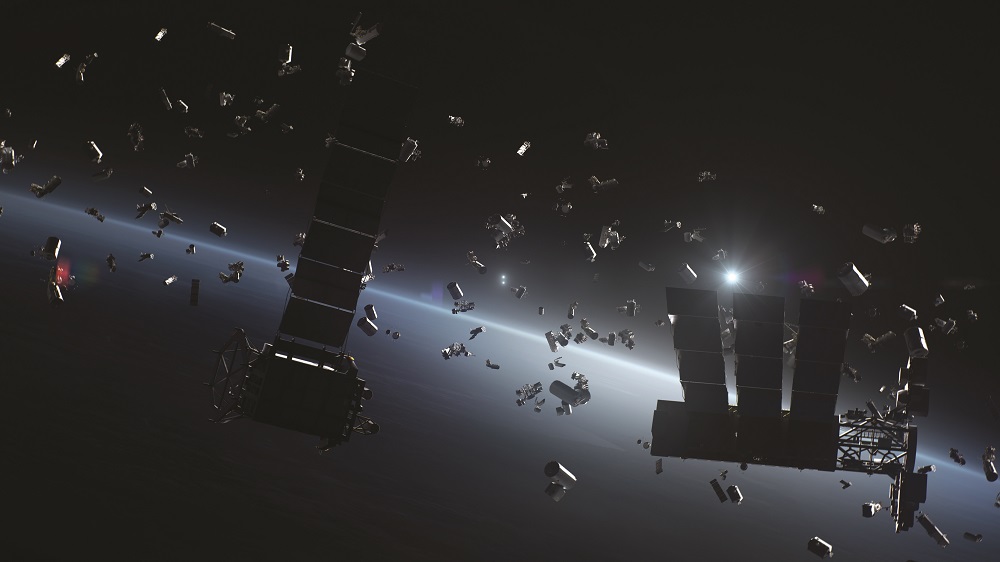WASHINGTON — As the Senate advances a bill that would direct NASA to support missions to remove orbital debris, the agency is outlining the role it will take assisting the Commerce Department on a new space traffic coordination system.
The Senate Commerce Committee advanced the Orbital Sustainability, or ORBITS, Act on a voice vote during an executive session July 27. A version of the bill made it through the Senate last year but was not taken up by the House.
“The ORBITS Act is going to empower NASA to research, develop and demonstrate key technologies to remove the debris,” Sen. John Hickenlooper (D-Colo.), lead sponsor of the bill, said in remarks at the session. “This bipartisan bill ensures that the United States remains the leader in responsible and sustainable uses of outer space.”
The core of the bill would direct NASA to establish an active debris removal program. That would include funding research and development activities “with the intent to close commercial capability gaps and enable potential future remediation missions for such orbital debris,” the bill states. NASA would also fund a demonstration mission for debris removal and allow it and other agencies to procure debris removal services.
The version of the ORBITS Act approved by the committee is different from the version introduced earlier this year. Among the changes is in a section that originally called on NASA to develop a prioritized list of orbital debris to remove. In the new version, that responsibility is given instead to the Commerce Department.
The Commerce Department, through its Office of Space Commerce, is developing a space traffic coordination system called the Traffic Coordination System for Space (TraCSS) that will take over civil space traffic management roles currently handled by the Defense Department. That involves taking in data from Defense Department and other sources and using it to provide warnings of potential close approaches to satellite operators.
While the Office of Space Commerce (OSC) is leading TraCSS, NASA will have a role. In a July 28 video presentation to update work on TraCSS, officials from the office and from NASA explained that NASA will be responsible for one of three elements of TraCSS, called HORIZON, that will focus on research and development.
“In this role, we will be creating an integrated development environment to provide OSC insight and guidance on the new space situational awareness data sources and services that could provide better coordination for space traffic,” said Sandra Connelly, deputy associate administrator of NASA’s Science Mission Directorate.
She described HORIZON as a “sandbox” to advance research in space situational awareness and space traffic coordination, serving as a test environment to carry out that work without affecting the operational TraCSS system. NASA will work to set up HORIZON “as quickly as possible” and also start working with the research community on related activities to support TraCSS by the end of the year.
HORIZON will also host a version of the main TraCSS system to allow for testing of new services, said Sandy Magnus, chief engineer for TraCSS at OSC. “We can do verification and validation in the appropriate environment to make sure new capabilities that we’re onboarding engage correctly and don’t break anything.”
TraCSS update
The other two elements, led by OSC, are OASIS, which will serve as the repository for space situational awareness data, and SKYLINE, which will provide the space traffic coordination application services, such as conjunction warnings.
The focus on TraCSS currently is developing a system for what OSC calls “phase one,” which is focused on tracking objects in orbit. Magnus said in the video that will be followed by phase two, to provide launch collision avoidance, or COLA, notices, and phase three, tracking reentries.
Phase one will itself be set up in steps in a “crawl, walk, run” manner, she said, with an initial capability ready by September 2024. “What we’ve planned is a very slow change from the commercial industry receiving data from the DOD over to TraCSS in a way that does not disturb current operations and allows everyone to get comfortable.”
The initial version that will be ready by September 2024, dubbed Phase 1.0, will largely replicate what the Defense Department offers now. “Our approach is to do no harm,” she said, ingesting data and producing conjunction data messages. One change will be that TraCSS will do screening for conjunctions every four hours, twice as frequently as the Defense Department does today. TraCSS will also improve incorporation of satellite position data from satellite operators, enabling more accurate predictions of conjunctions.
A Phase 1.1, Magnus said, will incorporate bug fixes. By early 2025, TraCSS will move into Phase 1.2, which will add data integrity monitoring. Phase 1.3, in the second quarter of 2025, will add what she called a “mission planning function” where the service would request additional tracking data for selected conjunctions that need higher quality data. By September 2025, Phase 1.4 will shift the conjunction analysis to a commercial provider and create a public interface for TraCSS.
Magnus did not provide a schedule for the second and third phases, but stated that the office has been in discussions with the Federal Aviation Administration about its launch COLA needs in phase two. Reentry management will be more complicated, with coordination needed with the Defense Department and FAA, she said.
